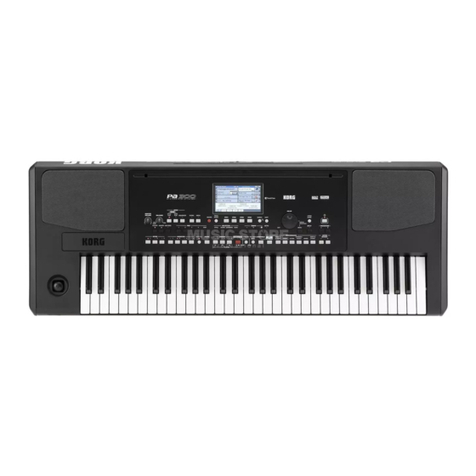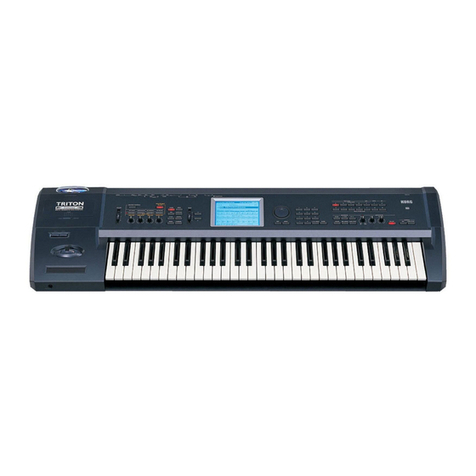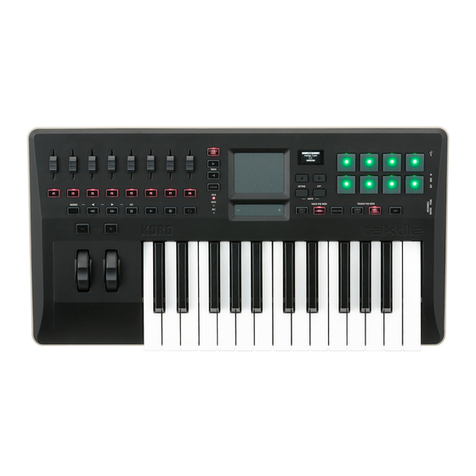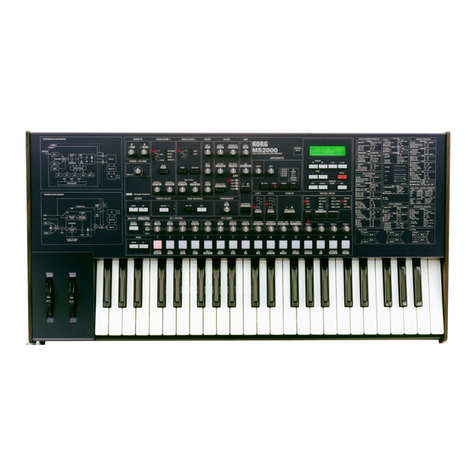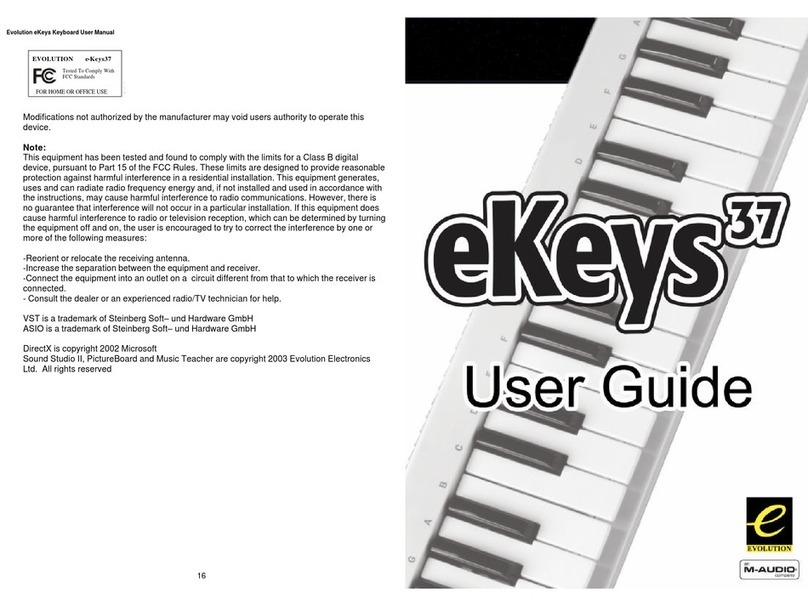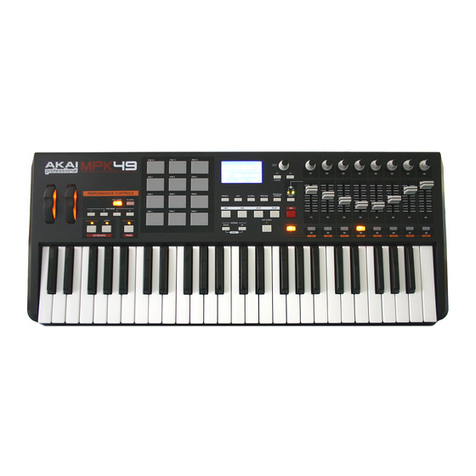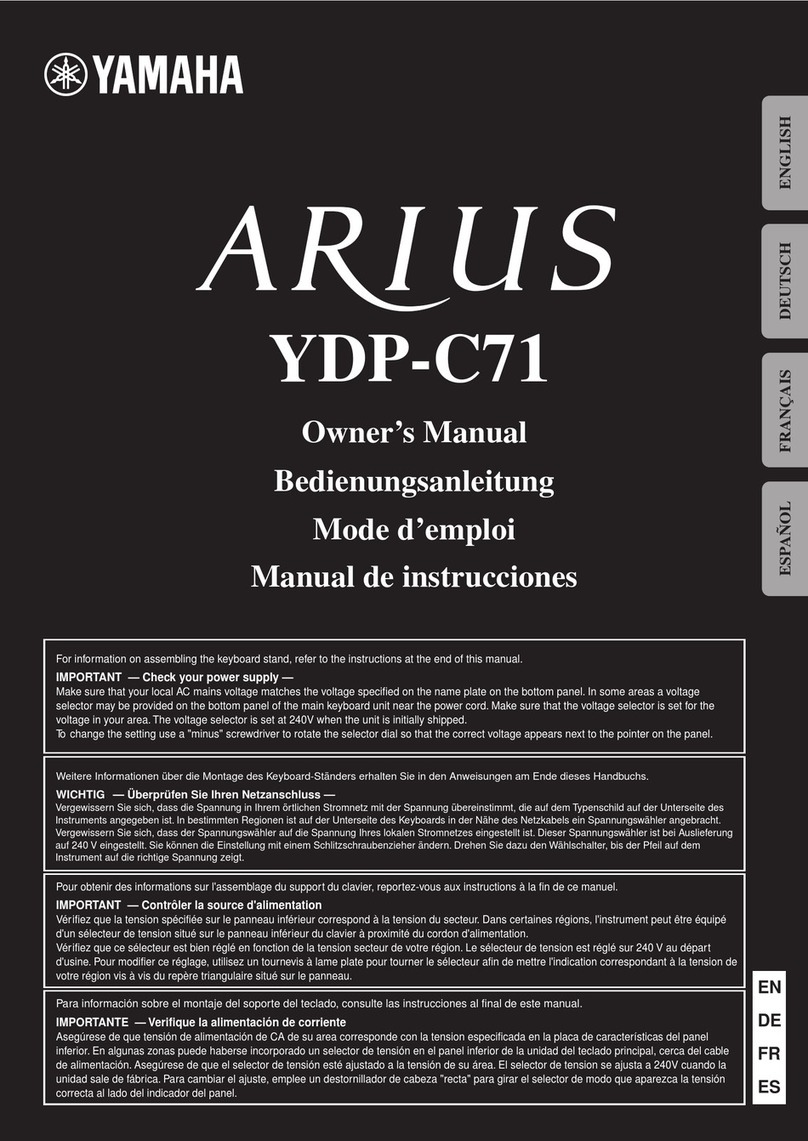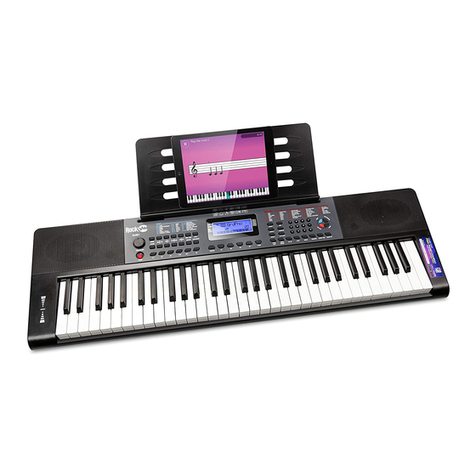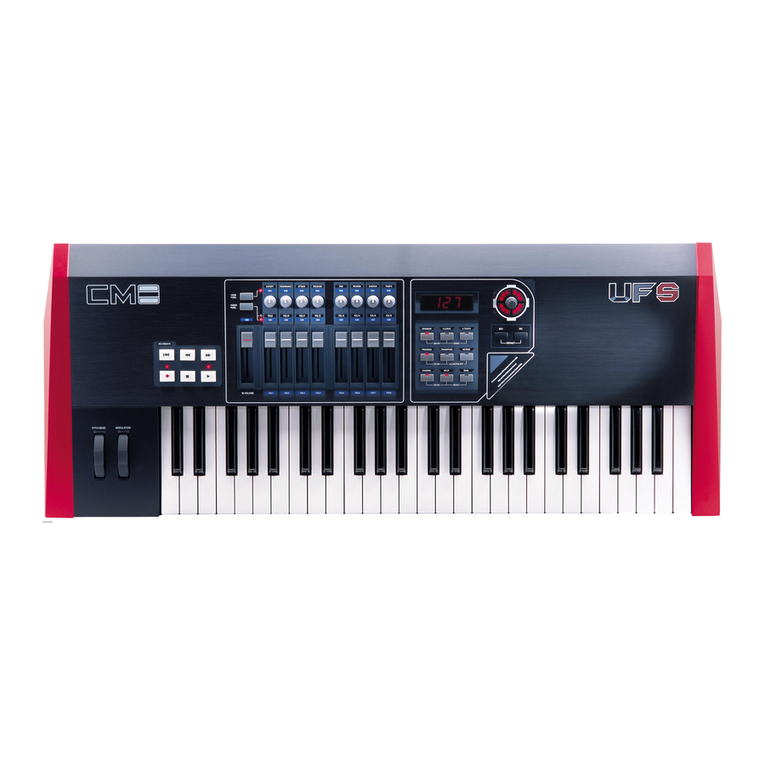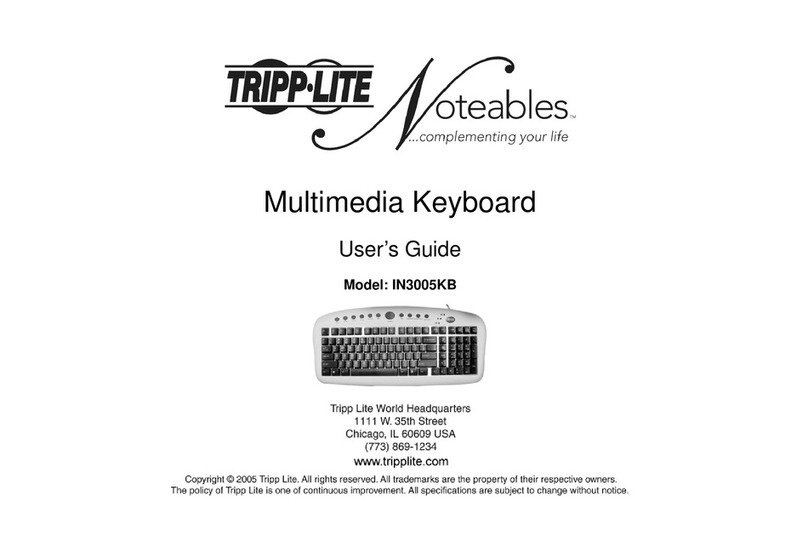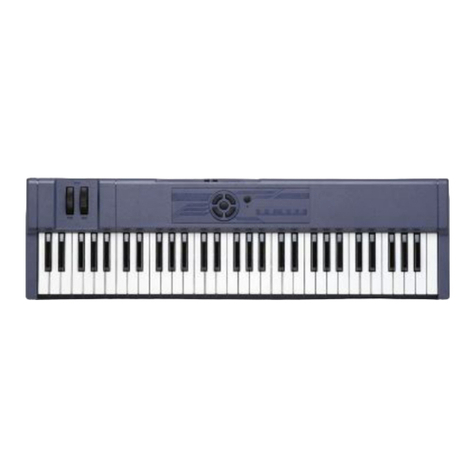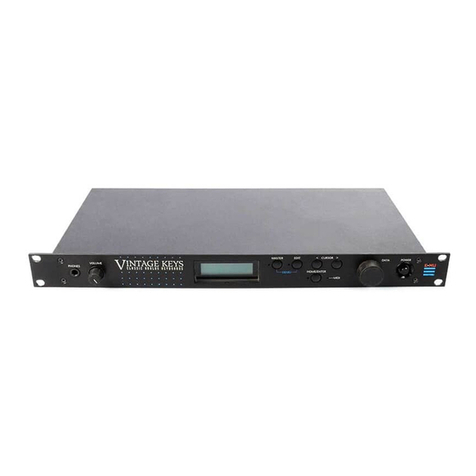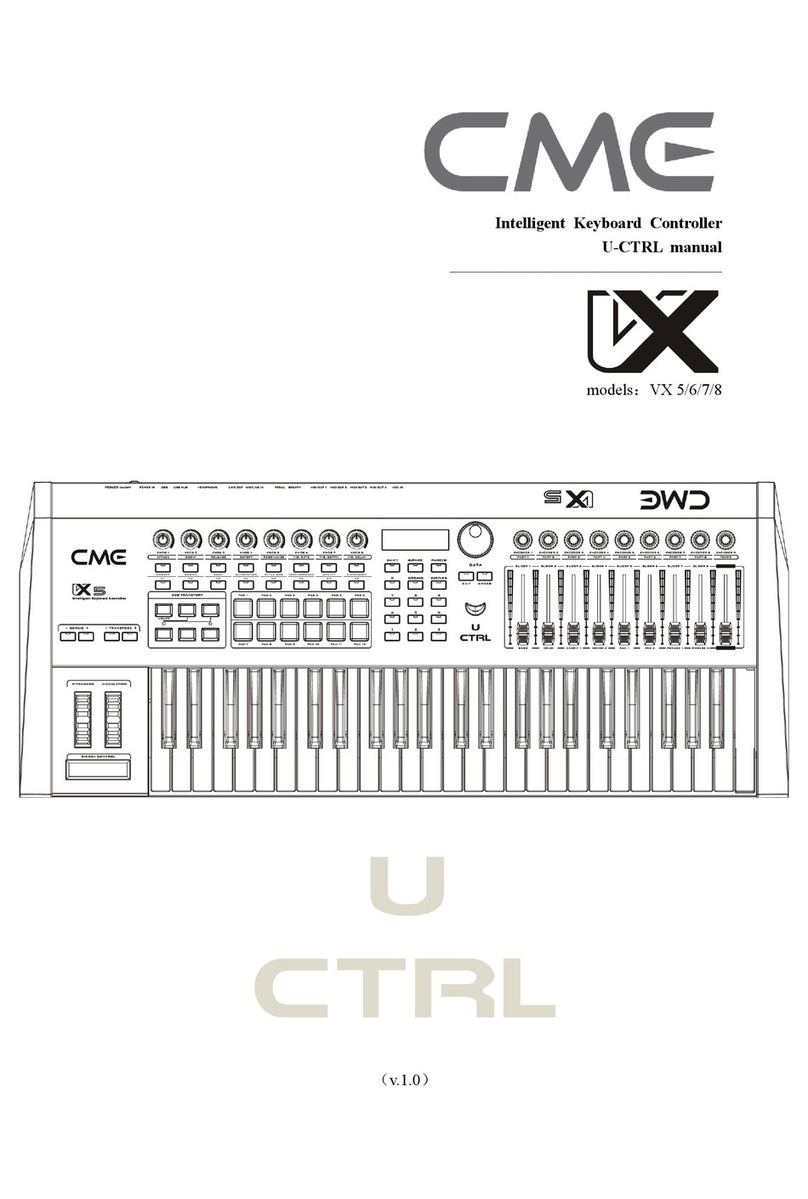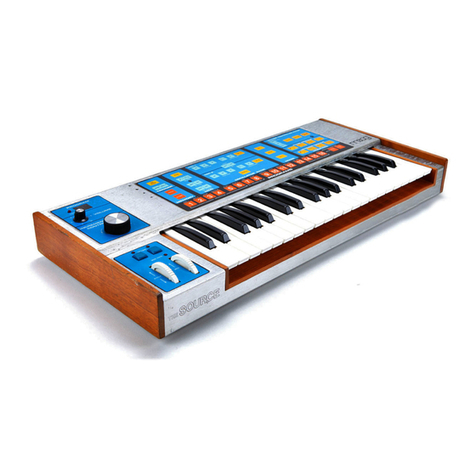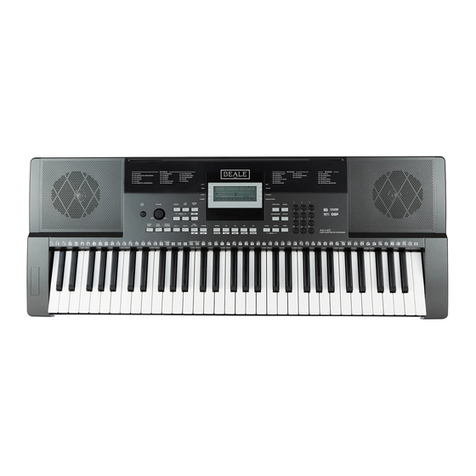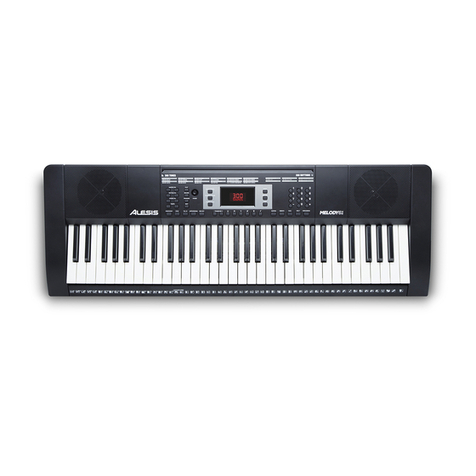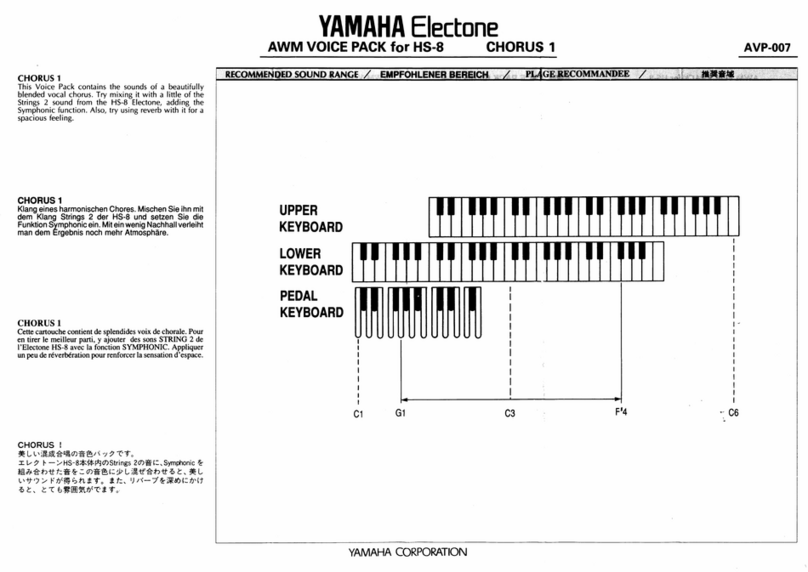Korg RK-100 User manual

REMOTE KEYBOARD
SERVICE D|X -4 AA
MANUAL IllV^IUU
CONTENTS
1. SPECIFICATIONS 2
2. MIDI IMPLEMENTATION 2
3. STRUCTURAL DIAGRAM 3
4. BLOCK DIAGRAM 4
5. CIRCUIT DIAGRAM 5
6. PC BOARD 6
7. CIRCUIT DESCRIPTIONS 8
8. TROUBLESHOOTING CHART 12
9. PARTS LIST 13
KEIO ELECTRONIC LABORATORY CORPORATION
TOKYO/JAPAN

1. SPECIFICATIONS
DC- IN
MIDI out (DIN socket)
2
UM-3 X6/AC adaptor (9V,
100mA minimum)
1,110(W) X293(D) X69(H)
mm
4.4kg (with battery)
Batteries (UM-3 X6)
MIDI cable (5m)
Control: Pitch bend wheel (Up, Down)
Modulation wheel (0—10)
Volume wheel (0-10)
Program up switch
Program down switch
Octave switch (H/M/L)
Modulation destination
1(Modulation wheel/Joy
stick +Ydirection)
2(Joystick -Ydirection)
Program select (1-1—8-8,
0-63 at MIDI)
Keyboard:
Octave:
Matched Model:
Program Select:
Program Number Display:
41 Keys (C-E)
H(60-100 at MIDI)
M(48-88 at MIDI)
L(36-76 at MIDI)
MIDI equipped synthesizer
Program number 0—63 at
MIDI
LED
Bank^ 8(Green)
Program ^7(Red)
Input Jack:
Output Jack:
Strap Pins:
Power Supply:
Dimensions:
Weight:
Accessories:
2. MIDI IMPLEMENTATION
Transmitted data
Status byte 2nd byte 3rd byte Description
10 0 1;0 0000kkkkkkk00 0 00000Note Off event ©o
10 0 10000: 0kk k kkkk01000000Note On event ^OVo
10110000000000010vVV V VVVModulation 1fiO —
1011000o; 0 0 0000100VVVVVVVModulation 2So
1011000o' 0 0000111 0V V V V V V V Output Volume SOO*?- —
1 1 00.0 0 0 o: 00PPPPPP— — Program change CO “*
1110. 000o' 00000000 0 b bb b bbb Pitch bend t®
1 1 1111ro' —— ——— — ——Active Sensing
Note:
1. When power is turned on, the RK-100 sends program
change (0 on MIDI), modulation, volume, and pitch
bend control change data according to positions of con-
trols on RK-100.
2. Note number (kkkkkkk) can be changed by the octave
selector,
L=36-76: M=48-88: H=60-100.
3. Destination switch position has the following effects.
At "1": MG wheel controls joystick +Y direction or
modulation wheel on a2-wheel equipped synth.
At "2": MG wheel controls joystick -Y direction only.
4. Program number (pppppp) covers the range of 0-63
MIDI.
5. Output volume (vvvvvvv) range is 0-127 MIDI.
6. Active sensing is sent every 200msec.
-2-

(a)
1
r
PART NO. PART NAME PART CODE
WOOOEM CASE IIVORV)
WOODEN CASE (BLACK)
WOODEN CASE (RED)
WOODEN CASE IWALNUTl
64S06600
fi4S0860l
64S06S0?
64608603
MAIN PANEL (BROWN) 64064701
NECK PLATE (BROWN) 64064901
JACK PLATE (BROWN) 64064901
BATTERY COVER (RED)
BATTERY COVER (IVORY)
BATTERY COVER (BLACK)
64066001
64066002
64065003
METAL PITTING OE DIN JACK 6406SI0D
METAL PITTING OF VR (A) 64065300
METAL FITTING OF VR (Bl 64066301
METAL FITTING OF PC BOARD 64065700
CONTROL WHEEL SPRING (A) 64905600
CONTROL WHEEL SPRING (B) 64906601
SCREWS OF BATTERY COVER 64402400
CONTROL WHEEL 64618900
Num6«r Of Scr*«vt BATTERY CUSHION 60009200
SLIDE SW MASK 55006400
SLIDE SW KNOB 62001600
FE BBZMC 3>8 STOPPER WASHER 64010300
FE BBZMC 6x16 MODEL NUMBER SEAL 68D20B0D
WS 0 BZMC 3.1x13 ADHESIVE TAPE ON BOTH SIDES
WS RBZMC 3.1x13 CORO KEEP PM.106 64010200
VN ZMC SERIAL NUMBER SEAL 40OSO
STRUCTURAL
DIAGRAM

BLOCK
DIAGRAM

1.Modification of CPU mask eliminates necessity of external ROM about CPU; CPU 6303R can be
used as adirect replacement of CPU 6301 -C27. In this case external ROM must be used, and port
(P2t )of this CPU (6303) should be connected to GND through 10k£2.
CIRCUIT
DIAGRAM


ooocia

7. CIRCUIT DESCRIPTIONS
The seven basic sections of the RK-100 are (1} the micro- (1) CPU
computer CPU, (2) memory, (3) A-D converter. (4) input, IC6 (HD6301) is an 8-bit microcomputer with internal 4K
|5) display, (6) MIDI data output, and (7) power supply. ROM and 128# RAM; it has the following four kinds of
We are going to simply explain as follows. PORT.
Port Term Type Furtction
Port 1(P10-P17)
8-bit
1
P10-P15
P16
P17
Output
Output
Input
Scan address of program indicator, keyboard matrix and shift sw.
A-D converter conversion start signal. Fig-1
A-D converter conversion completion signal. Fig-2
Port 2(P20-P24)
5-bit HOutput
Input
Input
Output
1Output
A-D converter address signal. Fig-3
Selection of internal or external memory.
250kHz clock signal (8 times MIDI clock frequency 31 ,25kHz)
Fig-4
1A-D converter address signal. Fig-5
MIDI signal.
Port 3(P30-P37)
8-bit P30-P37 Input/output
ports
A-D multiplex bus (Low order 8bits of address and data bus).
Port 4(P40-P47)
8-bit
P40-P43
P44-P47
Output
Output
pPD2764 address signal.
Selects 1C using data bus (HC240, M58990, mPD2746).
Fig-2 A/D Converter Conversion Completion Signal
O.lmsec O.lmsec
Fig-3 A/D Converter Address Signal Fig-4 Clock Signal
0.2msec 0.2m$ec
Fig-5 A/D Converter Address Signal -8-

The CPU of the RK-100 runs at 1MHz. The CPU reads in
VR A/D data at any time. For sending out the MIDI signal
from the output port P24, intervals of at least 5ms are
secured.
BLOCK DIAGRAM PIN CONFIGURATION
Vccjl O
xtau[T
extalQ;
NMi 13
^13
ST8y[T
PziH
PzzDo
PzjGI
P,oQ3
p|i [3
pizdl
P|3 [is
P|«[T7
Pi5 [ia
Pis[3
PitIzo
sc
El Pso
5sl P3I
Terminal Function
Term Function
VCC, VSS These two pins are connected to power supply and ground.
XTAL, EXTAL These two pins are clock supply terminals for the internal oscillator circuit. A1/4 divider produces
the unit's 1MHz system clock.
EEnable terminal for 1MHz system clock output.
RESET For resetting the CPU. Requires aminimum of 20msec low signal level, thereby determining the
time constant of the externally connected reset circuit.
IRQ Interrupt request input terminal for detection of sync input start/stop control signal (high to low
pulse).
SCI Address strobe signal output terminal. This signal controls LS373 which is used to latch the
least significant 8bits of the address multiplexed with data output at port 3.
P10-P17
P20-P24
P30-P37
P40-P47
These terminals function as 10 ports, address buses, or data buses depending on the operating mode
and software.
-9-

(2) Memory section
2764 is aprogrammable read only memory chip (erasable
by ultraviolet radiation). The capacity of this EPROM is
65,536 bits (8192 words X8).
AO—All are for address input; 00—07 are for data input/
output. Read mode is selected when CE (chip enable) is 0
and OE is 0.
The standby mode is selected when CE =1, regardless of
the condition of OE. In this case, 00—07 go to high im-
pedance. It is Impossible to output data.
From the CPU, control signal goes to ICIO {HC138}, the
Y7 output of ICIO controls the CE of /iPD2764. When
HC373, using aD-type latch, sets the LE control input to
high level, data is output as is; data is retained when this is
at low level. CPU port 3is aTDM address and data bus so
HC373 is used, distributing data among AO—A7 of
^PD2764.
2764
PIN CONFIGURATION BLOCK DIAGRAM
PIN NAMES
DATA OUTPUTS
(3) A-D Converter
IC7 (M58990P) converts analog signals into 8-bit digital
data; it has an internal multiplexer that selects 8-channel
analog input. BEND, MG, and VOLUME analog values are
received from INO, INI, IN2, IN3; when the M58990P OE
terminal is high, the digital signal is output from 2-1 and
through 2-8 and input to CPU port 3(P30—P37). Conversion
is initiated by the conversion start signal from CPU port 1,
(P16) and aconversion end signal is output from the EOC
terminal when conversion has finished; this goes to CPU
port 1,(PI 7). The A-D converter uses the same IMHz clock
signal as of the CPU machine cycle.
PIN CONFIGURATION
Andlofl Inptii
INi .
ST4ri lnou< START •
Cn<>of>Conv^iof) Ouipvit £OC«
0<9it4il Outpvt 3 S *
Output-EnAOl0Input 0€ ~
Clock Input CLK-
iSV)
Ktl*r«r>c« Voiiagt ('J REF (*)
lOV) GNO
0»giial OuUNi 2*7^
I*-, -c «)•*“ 1'*.
'
IN. —[7 IN,
IN, ^[T «] •- ‘N. .
IN. -E ^—ADDA
'[I
•Ci
-n.
•d
•Go
E
E
E
•E
El-
E'
E-
«]-
3-
E-
3-
3
3-
•ADO B
^
AddriM Input
-AOOC
'ALE Addrto LATcn>€rt«i>l0 Input
•2'^ Mse
22
.2.3 ^Oi9»W OulpuT
•2-4
'2-e Lse
REF <•) RiUrenc* Voliagt <*l
26D*9kUl Output
BLOCK DIAGRAM
Aratos Input V
Addreu Input
iN 9
IN *
IN i
IN •
IN 7
AOO A
ADO 8
Addtttt-LAIch-Cnablt Input ALE
Start Input
START Clock Input
CL K
REF l-l
Rr**ioncB Voltagr (-1
EOC Entf.ot.Conv«rpon Output
2•I
2-1
2-*
2-3
2-y
2-3
>Otpital Output
Vcc ISVI
GND (OV)
HEE(-1 OE
Rdettno Voltage (-) Output-Enapie Input
-10-

Functional Description of Terminals
Terminal Code Name I/O Function
INo -IN7 Analog signals 1These are the input terminals for analog signals. ADD A—ADD C
determine which of the 8inputs will be selected. The analog
voltage applied to these terminals is converted to adigital value
then output at terminals 2“^ to2“*.
ADD A- ADD CAddress signals 1These are the input terminals that select aterminal among IN,, to
INt. The address input of ADD Ato ADD Bis read to the address
latch at the rising edge of ALE.
ALE Address Latch Enable signal The strobe signal for reading the address signals input to ADD A
through ADD Cinto the internal address latch.
REF (+) Reference voltage (+) 1The reference voltage input terminal. The voltages of the (REF(+)
voltage >REF (-) voltage) REF (-) terminal and this terminal
cause voltage to be applied to the internal 256R ladder circuit.
REF (-) Reference voltage {— )1The reference voltage input terminal. The voltages of the (REF {+)
voltage >REF (—)voltage) REF (+) terminal and this terminal
cause voltage to be applied to the internal 256R ladder circuit.
OE Output Enable signal 1The control terminal for the digital data output terminal. When
OE is "L”, the terminals 2“^ to 2“^ assume afloating status;
when "H", digital data is output.
Digital signal 0The analog signals input to INo to INi are converted to digital
data then output at these terminals. When OE is "L", these
terminals assume afloating status; when "H", valid data is output.
2“‘ is the MSB and 2“® is the LSB.
EOC Convert End signal 0This terminal indicates the end of A-0 conversion. It is reset ("H”
^"L") by the START signal, and is set ("L” -"H”) by the end
of conversion. EOC is normally used as the interrupt signal to the
CPU.
START Convert Start signal This terminal signals the start of conversion. When rising from "L"
to "H", the internal registers are reset by successive approximation.
Conversion starts at the falling of "H” to "L".
CLK Clock input ID This is the clock input terminal that is the basis for internal timing.
(4) Input section
Key data goes through a41 diode matrix circuit, and
through IC5 (14050) and ICl (HC240) before reaching the
CPU. Likewise, PROGRAM NO., OCT DESTINATION, and
PROGRAM DOWN UP data reach the CPU via HC240
(buffer amp).
(5) Display
Data from the CPU goes through IC2 (LSI 38) and IC3
(LS138) to operate display of PROGRAM NO. (red) and
BANK (green).
IC2, 3, 8, 10, (TC40H138) are aline decoder performing
selection of one of 8outputs YO—Y7 using binary inputs
DA, DB, DC.
Selection is inhibited when E3 pin-5 is at high level, and all
outputs are up to high level.
(6) MIDI data output
The output signal from CPU port 1(P24) goes through
IC11 HC004 (inverter buffer) and 01 2SC2785 for inver-
sion, becoming the MIDI OUT signal.
(7)
Power supply
While a3-terminals regulator set in anormal stabilized volt-
age circuit is operated by 2-3 volts difference of input
voltage, the regulator in RK-100 can be operated by only
0.1 volt difference of input voltage for effective use of
batteries.
This produces astable +5V power supply voltage whether
using the external AC adaptor or internal vatteries (1.5V
X6).
If Input voltage drops from 9V to 6V, this circuits produces
abattery down indication via the 1C1 (2903) comparator
which detects the voltage drop and sends asignal to activate
the 1C1 (2903) multivibrator circuit into oscillation. This
oscillator signal goes through IC2 LSI38 and IC3 LS138to
illuminate the LED display.

8. TROUBLESHOOTING CHART
RK-100 Troubleshooting Chart {for the RK-100 connected to the EX-800 with aMIDI cable)
1No power (LEDs not illuminated). 2No change in program no. &bank display.
Make sure if
AC adaptor is
connected or if
good batteries
are properly
inserted.
Are the LEDs
properly
illuminating?
Is +5V ^
at KLM-618
CN3-1B? ^
Check KLM-620
IC2, 3. LS138.
and KLM-621
LED board and
connector, CN4A,
and CN5A.
^Cut
KLM-615 CN3-1B,
'CN3-2B +5V line^
*\po you find
\+5V?/
Check KLM-620
ICs and board
pattern.
Check KLM-618
power supply
circuit and
KLM-619.
Bend, MG, volume, do not work.
Check KLM-620
IC6 12 pin IP24)
with oscilloscope. ^
Is there anormal MIDI
serial data signal?
Check MIDI
receiving
dev ice
lEX-800).
Check that
EX-800 bend.
MG, volume,
are not at 0.
Check whether
<EX-800
parameter 86
is at ENABLE"
Check KLM-621
CN7-2A, CN7-3A.
Check whether
there is achange
v>^en the
PROGRAM
switch is pressed.
Is there
'char>ge when
the program /
“switch is pressed?
Set EX-800
parameter 86
to ENABLE
ID.
Y
^Check
DC1 HC240>
ICS, and IC9.
Are they y*
^changed?
Check ICS
HD6301, CPU,
power supply
voltage at
\+5V? /Go to (1 )check power
supply problems.
KLM-620 connectors
*lf the RK-100 is okay but the EX-800
won't work, it might be set to
DISABLE or the MIDI cord may be
broken .On the other hand, if the
EX-800 works okay but the RK-100
display or other part of the RK-100 is
doesn't work, then check the circuitry
related to that section.
-12-

13
-
9. PARTS LIST
PARTS PARTS NAME P.C. IDENTIFICATION NO. Q'TY
CODE S>>ECIFICATIONS BOARD FUNCTION
CARBON RESISTORS
10416310 1/6JTP lOOn ]
KLM-620 1
10416315 1/6JTP 150n 1
10416322 1/6JTP 220n KLM-618-4 4
10416333 1/6JTP 330n KLM-620 1
10416410 1/6JTP 1.0K KLM-618-4 1
10416447 1/6JTP 4.7K 2
10416510 1/6JTP 10K 1
KLM-620 3
10416522 1/6JTP 22K KLM-618-4 3
10416533 1/6JTP 33K 2
10416547 1/6JTP47K 2
KLM-620 1
10416610 1/6JTP 1O0K KLM-618-4 3
KLM-620 1
10416622 1/6JTP 220K KLM-618-4 1
BLOCK RESISTOR
13508510 RKC1/8B8J 10K KLM-620 1
MYLAR CAPACITOR
20402510 50V O.OI^iF KKLM-620
.. 1^
CERAMIC CAPACITOR
|
21452330 50V 33pF TP KLM-620 2
21465100 50V O.OlpF TP KLM-618-4 1
21456100 25V 0.1*«FTP KLM-620 8
ELECTROLYTIC CAPACITORS
25441310 6.3 V100*iF KLM618-4 1
25443210 16V 10*iF 1
KLM-620 3
25446110 50V 1/iF KLM-618-4 3
KLM-620 2
TRANSISTOR
30100328 TR 2SB744 AP/Q KLM-618-4 2
30420020 TR 2SC2785 KTN 1
PARTS PARTS NAME P.C. IDENTIFICATION NO. Q'TY
CODE SPECIFICATIONS BOARD FUNCTION
DIODES
31001500 SR1K-2 KLM-618-4
31401300 1SS-133 T-77 KLM-620
LED
31204300 LED SLP-181B Red
1
KLM-618-4
31204400 LED SLP-281B Green
ZENER DIODES
31422600 HZ-9A2-TD KLM-618-4 1
31422900 HZ-3BLL-TD 1
31423000 HZ-3B2-TD 1
1C
32003068 TC74HC74 KLM-620 Dual D-type flip flop
32003104 TC74HC04 PHex inverter
32003137 TC74HC138 P3line to 8line decojrder 2
32003167 TC74HC240 POctal buffer (inverted) 1
32004016 HD-14050 BP Hex buffer (Non inverted) 2
32004080 HD-6301V1C96 PCPU 1
32009001 NJM-4558D-V KLM-618-4 OP AMP 1
32009015 NJM-2903 D OP AMP 1
32011036 M58990 P-1 KLM620 A/D converter 1
32021033 SN-74LS138 3line to 8line decoder 2
CERAMIC OSCILLATOR
33501400 KBR-4.0MHZ KLM-620
ROTARY VR
36018200 VR K161100VR-10KB Bend 1
36018400 VR K161100VIA-10KB Volume, MG 2
SLIDE SW
37301600 SSB-123014 KLM-618-4 Octave
37301700 SSB-1 22020
1 . .
Destination
POWER SW
37506600 WK-2A44 Kl 1

14
-
PARTS PARTS NAME P.C. IDENTIFICATION NO. Q'TY
CODE SPECIFICATIONS BOARD FUNCTION
PUSH SW
37507000 TM1-01 KLM-618-4
KEY BOARD
42002700 ESK-729
42203500 C
42203600 D
42203700 E
42203800 F
42203900 G
42204000 A
42204100 ^B1
42204300 Black key
42205706 Key contact x6
42205707 Key contact x7
DC INPUT JACK
45400300 HEC-0470-01 -230 |
1
KLM-618-4
DIN JACK

PARTS
CODE PARTS NAME P.C.
SPECIFICATIONS BOARD IDENTIFICATION NO,
FUNCTION
SLIDE SW KNOB
62001600 ISSB L=6 Black
PUSH SW KNOB
62013900 22100304 Gray KLM-618-4 Program No. 1~8
62013903 22100311 Light gray Shift
62014000 21100204 Gray Up, down
MAIN PANEL
64064701 Brown
KOC-C30218
64064801 Brown C20133
NECK PLATE
JACK PLATE
^64064901
C71 I
Brown C40526
BATTERY COVER
64065001 IRed C40527
64065002 IIvory C40527
64065003 IBlack C40527
64065100 IC40528
64065200
64065300
64065301

16
-
PARTS PARTS NAME P.C. IDENTIFICATION NO. Q'TY
1
CODE SPECIFICATIONS ,BOARD FUNCTION
J
762631 13
1
WS 0BZMC 3.1x13 4
76363113 WS RBZMC 3.1x13 4
INNER CARTON BOX WITH PACKING
80018000 RK-100 1
I
Other manuals for RK-100
1
Other Korg Electronic Keyboard manuals
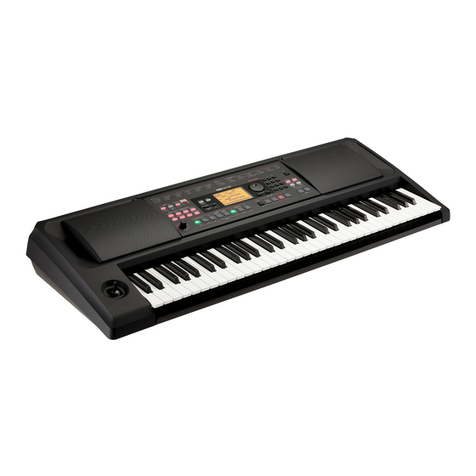
Korg
Korg EK-50L User manual
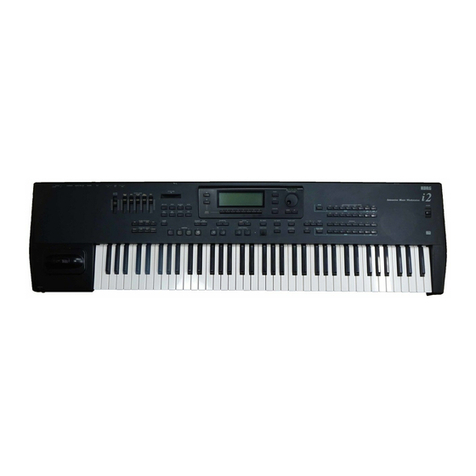
Korg
Korg i2 HD User manual
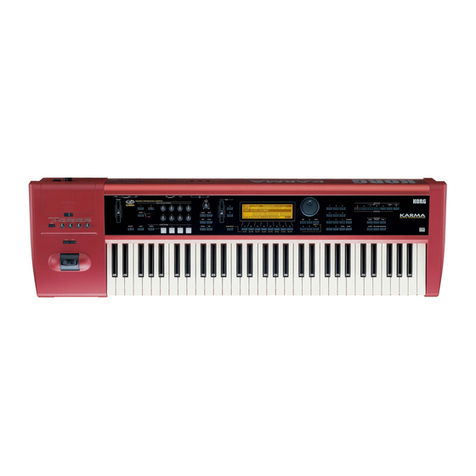
Korg
Korg Karma Instruction Manual
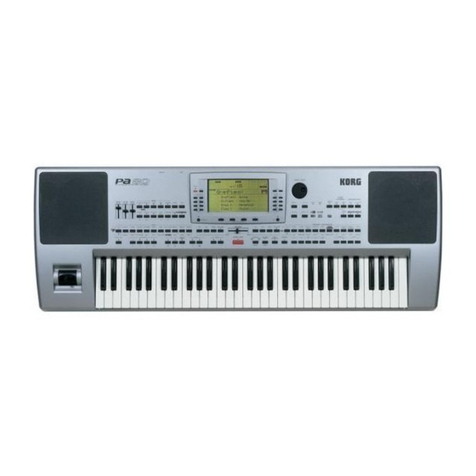
Korg
Korg PA80 Product information sheet

Korg
Korg DL-50 User manual

Korg
Korg MICROKEY2-61AIR User manual
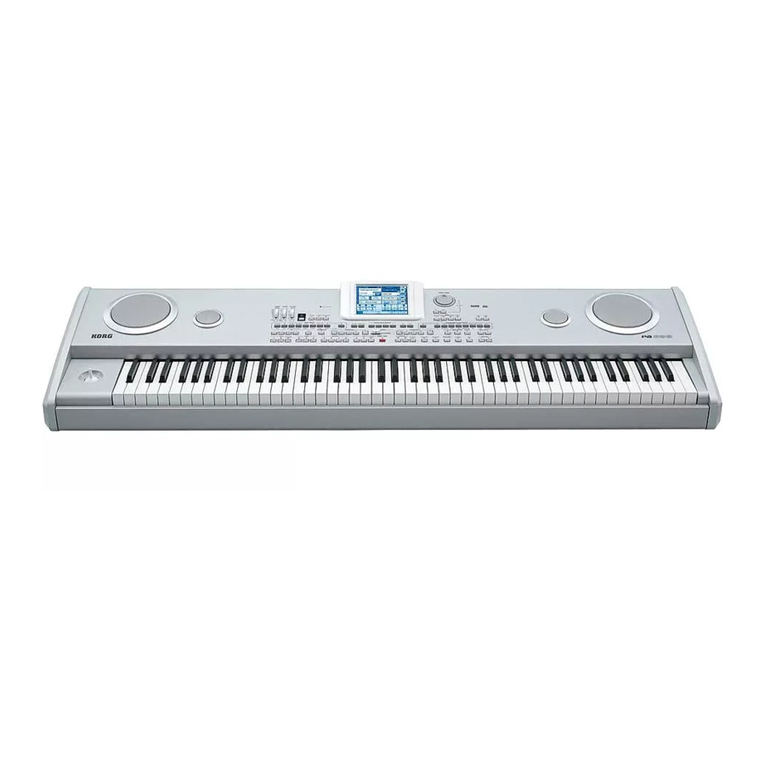
Korg
Korg Pa588 User manual
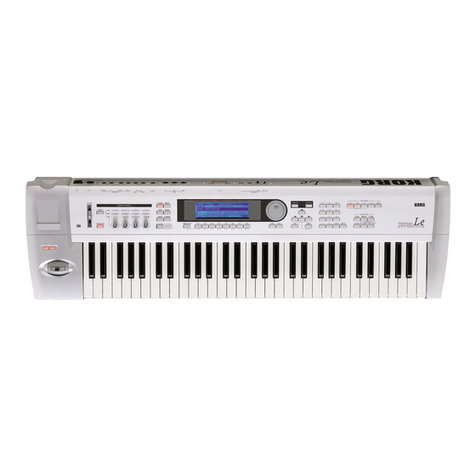
Korg
Korg TRITON Le User manual
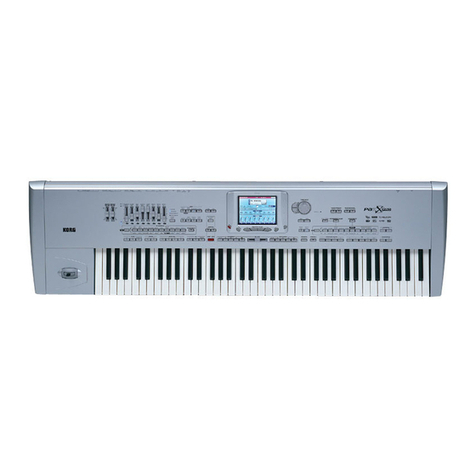
Korg
Korg PA1X Product information sheet
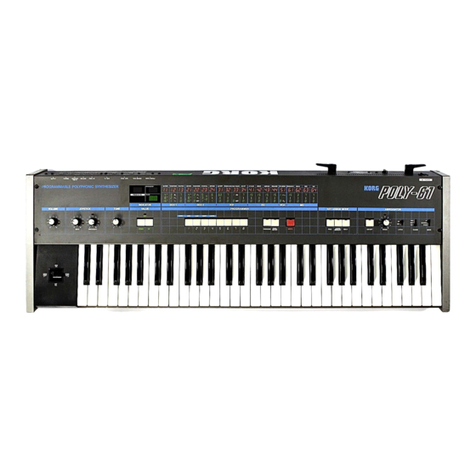
Korg
Korg POLY-61 User manual
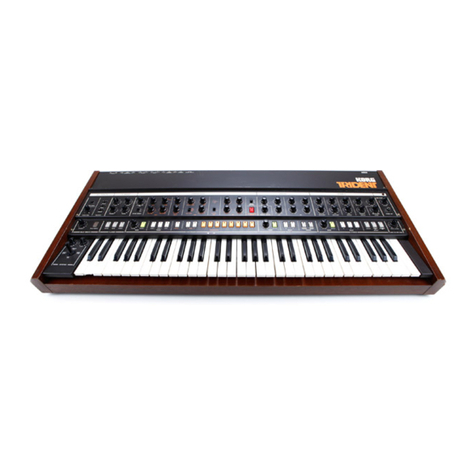
Korg
Korg Trident MK1 User manual
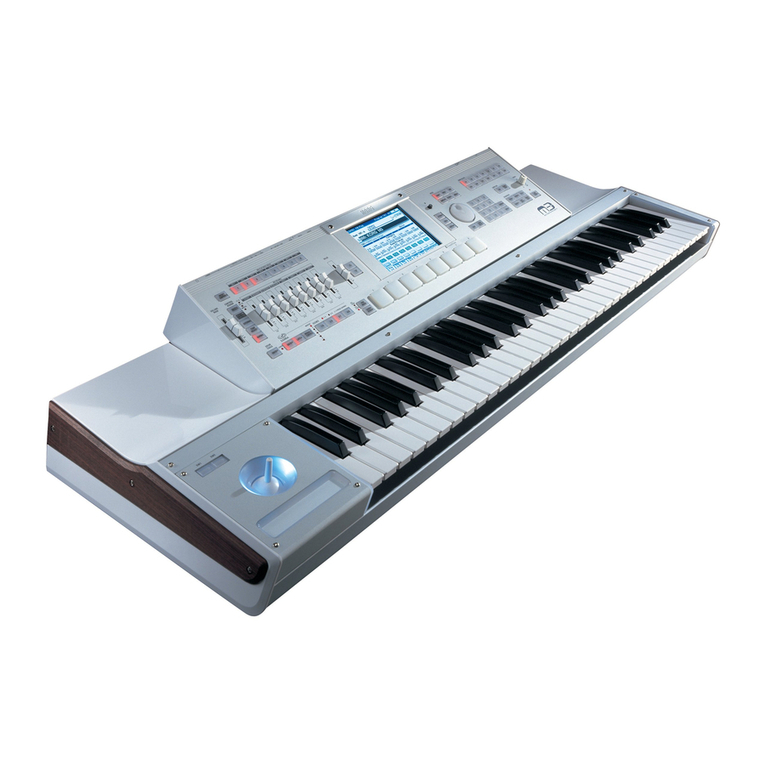
Korg
Korg M3 User manual
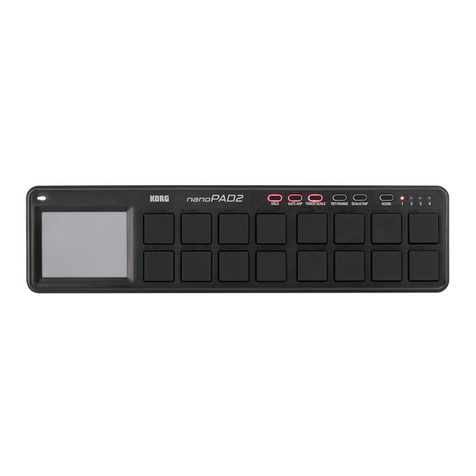
Korg
Korg nanoPad2 User manual
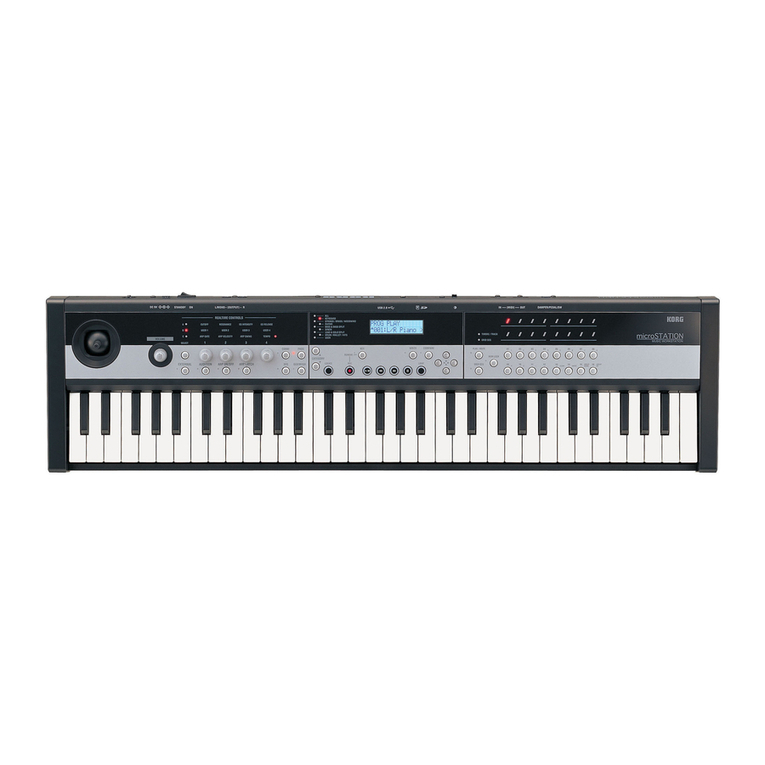
Korg
Korg microSTATION Instructions for use
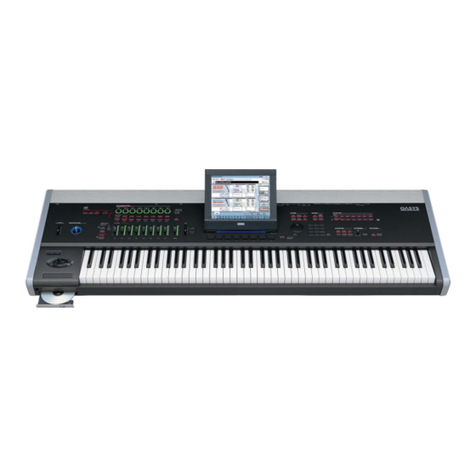
Korg
Korg Electronic Keyboard User manual

Korg
Korg M3-73 User manual

Korg
Korg Pa300 User manual
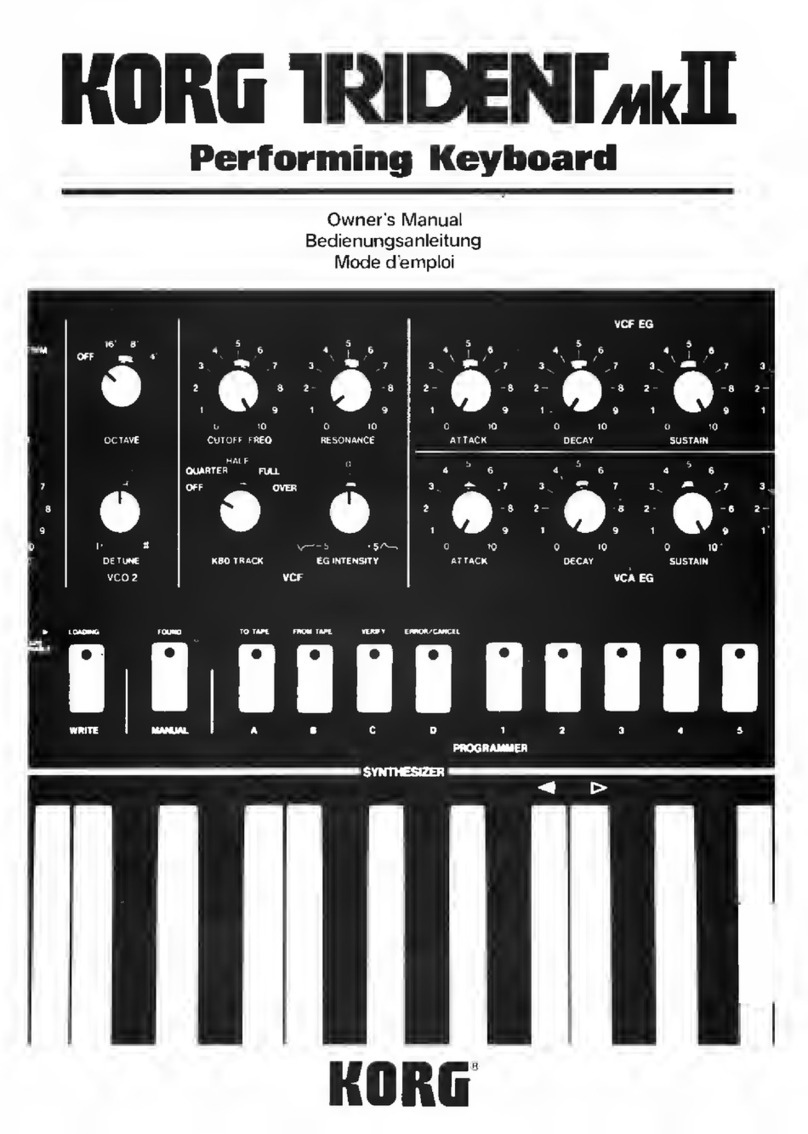
Korg
Korg Trident Mk II User manual
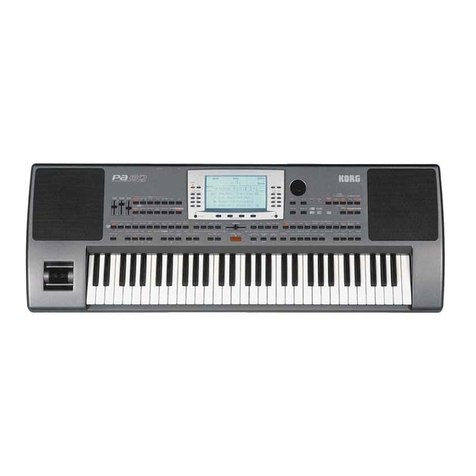
Korg
Korg PA60 Product information sheet
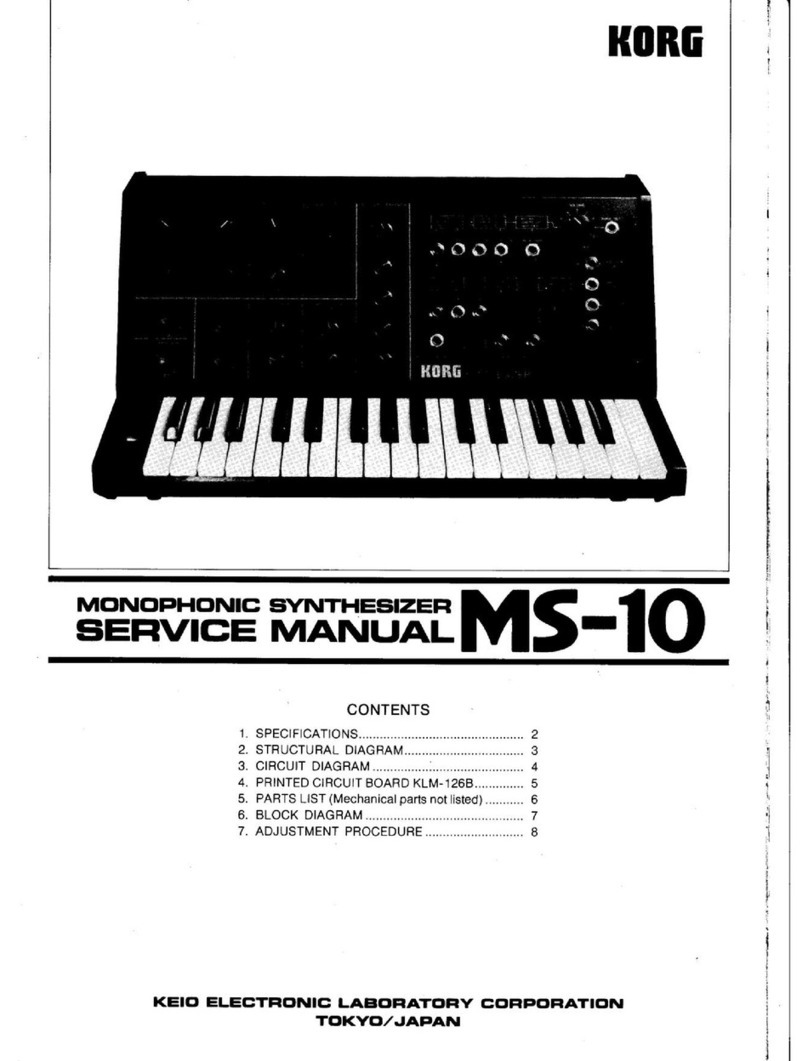
Korg
Korg MS-10 User manual
